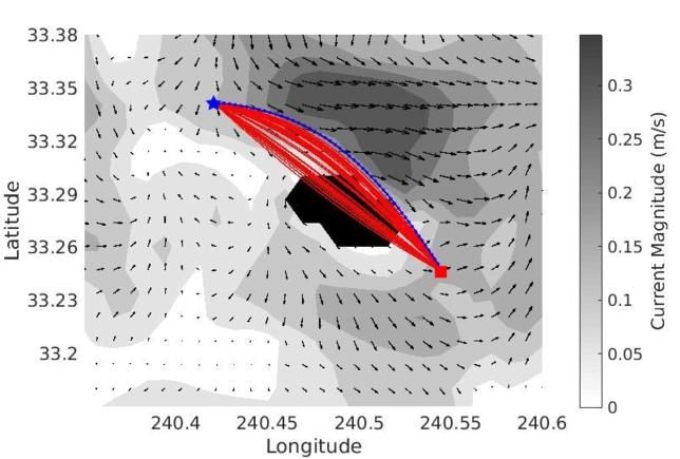Jul 21 2017
Robotics Researchers have discovered a way for the navigation of strong currents by autonomous underwater vehicles with greater energy efficiency, meaning that the AUVs will be able to collect data in a much better and longer way.
 AUV paths planned by framework Credit: Oregon State University.
AUV paths planned by framework Credit: Oregon State University.
AUVs like underwater gliders are considered to be valuable research tools primarily limited by their energy budget – every bit of battery power wasted through ineffective trajectories cuts into the time they can spend working.
Historically, a lot of oceanography data sets and sampling came from using ships, which are expensive and can only really be out for a few days at a time. With autonomous underwater vehicles, you can get months-long monitoring. And a way to extend those vehicles’ missions is through smarter planning for how they get from one point of interest to another.
Dylan Jones, a third-year Ph.D. Student in Oregon State University’s Robotics Program and Lead Author on the study
Jones and Ph.D. Advisor Geoff Hollinger, Assistant Professor of Mechanical Engineering in OSU’s College of Engineering, have developed a framework enabling the vehicles to plan energy-efficient trajectories via disturbances that are powerful and uncertain, such as and wind fields and ocean currents.
The framework has an algorithm that samples alternate paths, and also comparison metrics that allow a vehicle to decide when to exactly switch paths based on new information gathered on environmental disturbances.
The framework was tested in a simulated environment, referring to a data set of currents from the Regional Ocean Modeling System, and it was also tested on a windy lake with an autonomous boat.
The findings have been recently published in IEEE Robotics and Automation Letters and they reveal that the algorithm is capable of planning vehicle paths that are more energy efficient in comparison to those planned by the currently available methods. The results also highlighted that the algorithm is strong enough to handle environments for which much data is not available.
Findings also suggest that three of the framework’s five path comparison metrics can be employed for planning increasingly efficient routes when compared to planning exclusively based on the ocean current forecast.
We generalized past trajectory optimization techniques and also removed the assumption that trajectory waypoints are equally spaced in time. Removing that assumption improves on the state of the art in energy-efficient path planning. These are under-actuated vehicles – they don’t go fast in relation to the strong ocean currents, so one way to get them to travel more efficiently is to go with the flow, to coast and not use energy. We’re building more intelligence into these vehicles so they can more reliably accomplish their missions.
Dylan Jones, a third-year Ph.D. Student in Oregon State University’s Robotics Program and Lead Author on the study
Jones highlights that overcoming powerful disturbances is a vital component of putting any type of robot in a real-life environment. Earlier planning algorithms have not always taken into account the dynamics of the vehicle they were planning for, he said.
“Sometimes we make assumptions in the lab or do simulations that don’t translate in the real world,” Jones said. “Sometimes a disturbance is too strong to be overcome, or sometimes it can be overcome but the path deviates so significantly that it would put the robot in a danger area. We have to consider all the possible locations of a robot. There are smarter ways of considering these various disturbances, and this gives us a better way of planning paths that are least affected by disturbances.”
According to Jones, any disconnect between the planner and the controller can be dangerous.
The way we see this work going is to bridge that gap – how do we look at paths that are easier for controllers to follow, and how do we make controllers follow paths better? We can be more energy efficient when we consider the whole environment, planning paths so that the controller of the vehicle doesn't have to work as hard.
Dylan Jones, a third-year Ph.D. Student in Oregon State University’s Robotics Program and Lead Author on the study
Research in the future will also deal with “informative path planning” – planning paths that originally collect information about the environment and disturbances that the algorithm can use later in order to plan more energy-efficient routes.
“How do we combine these two ideas – planning a path for energy efficiency while also trying to gather information that will inform efficient path planning?” Jones said. “There will be tradeoffs and it might come down to, do I pay five hours now to save six hours later on? Another possible research direction is to look at a multi-vehicle situation where one vehicle can scout ahead and relay information to one or more others – they could possibly have a low shared energy cost by intelligently assigning goals and sharing information.”